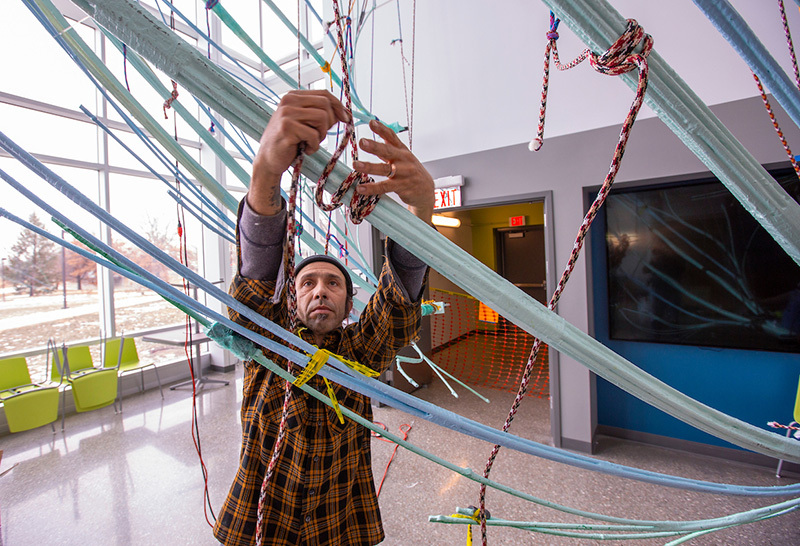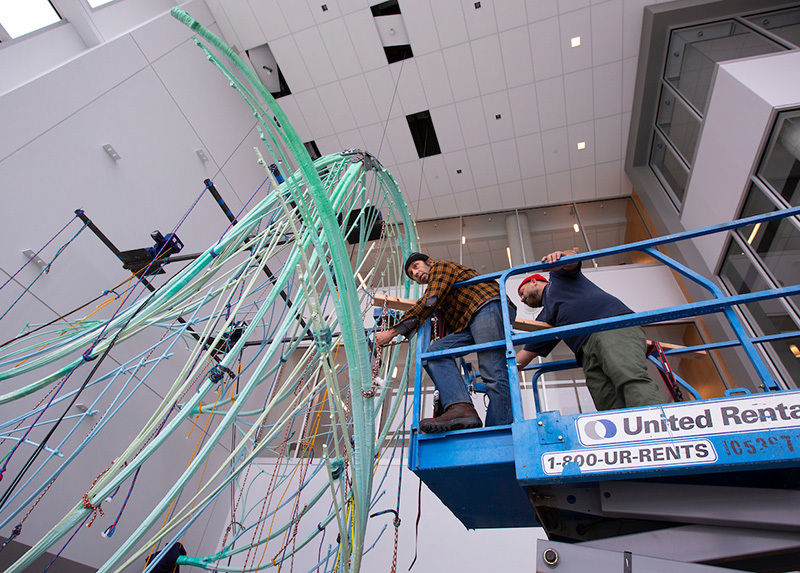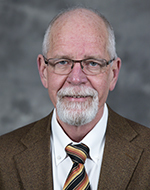Art on campus

Photos by Christopher Gannon.
(Above) Los Angeles-based artist Gaston Nogues begins the exacting task of installing Organic Dreams Synthetic Means in the north atrium of the Advanced Teaching and Research Building earlier this month. The fiberglass rods sculpture is the second piece Nogues and his partner, Benjamin Ball, created for Iowa State. The first was installed last January in the Bessey Hall east addition, the other piece of an $88 million biosciences facilities upgrade.
Nogues said the artwork was inspired by the scientific function of the building. "We want to have synergy with the building," he said.
The sculpture joins University Museums' Art on Campus collection. It's also one of the last acquisitions through the Iowa Art in State Buildings program, which designates 0.5 percent of new or remodeled building funds for public art. The 2017 Legislature repealed the requirement, but projects underway at that time may be completed.

Service delivery team assignments announced
Before break
More ISD information will be emailed and posted online Friday, Dec. 21, including:
- Position descriptions for HR and finance specialists
- Transition timeline
- FAQ updates
A major piece of the improved service delivery puzzle fell into place when assignments for 11 service teams of finance and human resources specialists were announced Dec. 14.
Feedback gathered since HR and finance improved service delivery (ISD) models were introduced in October showed widespread confusion with the term "unit." Instead of defining units, 11 teams -- named for tree species -- are assigned to colleges, departments and offices within ISU's five divisions. For example, the Redwood team will serve the College of Engineering's academic departments, research centers and administrative units. The Juniper team will serve three colleges (Business, Design and Graduate), the library and academic affairs division administration (provost office, CELT, lectures program, etc.). Academic departments that are co-administered by colleges will be served by the Spruce team.
All university areas have service team assignments, including the Ames Lab and ISU auxiliary units (for example, athletics and alumni association). Service teams are not assigned to independent entities affiliated with the university, such as the ISU Foundation and Iowa State Center.
About the teams
University human resources worked with the finance division and top ISU administrators to develop the teams. Assignments are based primarily on the size (personnel headcount) and complexity (HR, finance and payroll processes) of the areas they serve, with attention to the university's existing organization structure. The assignments, sorted by team name and division, are available on WorkCyte's ISD website.
"We surveyed senior leaders (president, senior vice presidents, VP for research, VP for Extension and Outreach, deans, and Ames Lab director) to inform the service team assignments," said Kristi Darr, interim vice president for university human resources. "We wanted to make sure we took into account their unique needs, which is why, for example, there is a service team (Spruce) to support the dually administered academic departments."
The work that specialist teams will do is tied to processes and transactions in the Workday software system going live campuswide July 1, 2019. The number of HR experts on each team is expected to be proportional to the headcount. Finance specialist numbers will vary -- for example, some areas will need numerous grants experts, while others need none.
"All of these teams will be right-sized for the areas they're serving," said Pam Cain, interim senior vice president of finance and university services. "We'll determine the approximate number of specialists needed in early January."
Who's filling the specialist roles?
Final position descriptions for the HR and finance specialist roles will be posted by Friday, Dec. 21. Employees (and supervisors) interested in learning more about the positions should attend the Jan. 8 job showcase in the Memorial Union.
A preview of the employee interest survey used to help match staff with specialist positions will be available before the job showcase, then posted Jan. 9-18 for employees to complete online. Staff must complete the survey to be considered for a specialist position. Qualified ISU employees with interest in specialist positions will be considered before external searches are launched.
The ISD structure changes supervisory lines, but specialists may continue serving their current unit as part of its service team. Staff doing HR and finance work in colleges, departments, centers and offices can indicate their placement preference on the interest survey.
"We want to accommodate, to the extent possible, employees' desires to support a specific area of campus," Cain said. "We're committed to filling the specialist positions with our current employees, and we'll do that by evaluating your job skills and not just a resume."
Moving forward
Transition teams will be formed to help units identify and manage ISD changes in their areas. That includes:
- Reassigning non-ISD duties done by staff who move into specialist positions
- Redefining position responsibilities for staff who do not move into the ISD structure though their HR/finance duties do
Phased implementation of the ISD structure is moving quickly to stay on track with Workday's go-live date. Finalists interviewed this week for the HR and finance associate vice president positions that will help lead ISD, and Dec. 16 was the deadline for guaranteed consideration for the finance manager and senior human resources partner positions that will supervise the specialist teams.
A few changes are coming for employee benefits, most taking effect Jan. 1
Following the recommendations of the university benefits committee (UBC) earlier this month, university administration approved several changes to employee benefits, most of which are effective Jan. 1. These are in addition to the changes announced before open enrollment in November.
The UBC has an advisory role on employee benefits, making recommendations to the senior vice president for finance. UBC chair Mark Power said the committee works closely with administration in challenging budget environments to manage benefit costs while maintaining quality. The changes taking effect in 2019 are meant to improve administrative efficiency, control costs, comply with industry practices and expand voluntary offerings.
"Importantly, ISU Plan medical and dental plan design and employee cost-share have remained unchanged for five consecutive years," said Power, University Professor of finance. "Benefit costs are dynamic and the UBC, in conjunction with university administration, must continue to embrace innovations to ensure benefit sustainability."
Long-term disability
The formula used to determine payments for employees on long-term disability has been 75 percent of the first $1,000 per month plus 60 percent of the gross income above $1,000. The insurer, Principal Financial, advised that most policies now use a single percentage to calculate payments, generally from 60 percent to 66.7 percent. Effective Jan. 1, the ISU plan will cover 63 percent of an employee's salary. Employees may notice slight changes to the deductions listed on their paychecks, but the premium remains 100 percent covered by ISU after the first year of employment.
A new voluntary group plan will be offered through Principal for employees who want additional long-term disability coverage to supplement the university-provided plan. Employees would enroll directly with Principal, paying after-tax premiums not set up through payroll deductions. It hasn't been determined when that policy will become available. University human resources (UHR) benefits staff and Principal will share information about the plan in early 2019.
New and departing employees
New employees currently are eligible for medical and dental coverage on their first day of employment, provided they take action to enroll in benefits. The university has covered the employee share of medical and dental premiums during the month of hire, unless the start date was the first day of the month. Beginning July 1, 2019, employees will continue to be offered immediate coverage but will pay their share of medical and dental coverage in their first month of employment. If the start date falls on the 14th day of the month or earlier, the employee will pay a full month's premium for the plans. Employees who start on or after the 15th will pay half of the monthly premium. Until July 1, the current practice will continue.
Beginning Jan. 1, the university no longer will offer the subsidized active-employee rate for health and dental coverage through the end of the month that follows the month in which employment ends. Instead, ISU active-employee coverage will extend until the last day of the month employment ends. Retiree and COBRA plans remain available for former employees who wish to keep their coverage. Opting to continue coverage requires departing employees to pay the full premium, beginning the first full month immediately after the separation date.
As part of this change, tenured faculty departing at the end of the academic year will no longer receive employee-rate coverage through the summer months.
Eligibility requirements
Employees must work at least half time to be eligible for non-retirement benefits, but a change effective Jan. 1 removes the requirement that the appointment be at least nine months. Temporary and seasonal workers will continue to be ineligible for benefits.
Eligibility rules for participating in the defined-contribution retirement plan also change Jan. 1, removing the current requirements for employees to be at least half-time, on an appointment of at least nine months and earning at least $7,800 per year. Due to those requirements, most employees who didn't qualify defaulted into the Iowa Public Employees Retirement System (IPERS), as long as they made $1,000 or more in two consecutive quarters. This change allows most new hires to choose between IPERS or the defined-contribution TIAA plan. State rules prevent employees from switching retirement plans after their initial choice.
Questions?
Questions about any of these changes may be directed to the UHR benefits office at benefits@iastate.edu or 294-4800.
Carter is retiring as research park president; Madden named to interim post
A national search will begin next month for the next president of the ISU Research Park. Steve Carter, who has led the nonprofit research park since 2000, will retire from Iowa State on Dec. 31. Warren Madden, who retired as senior vice president for business and finance in June 2016 after a 50-year career at Iowa State, will serve as interim research park president, effective Jan. 1, 2019.
Interim vice president for economic development and industry relations David Spalding said the Buffkin/Baker search firm, Winston-Salem, North Carolina, will assist with the search. The firm's primary role is to identify qualified candidates and build a strong candidate pool. Michael Crum, Ruan Chair in Supply Chain Management in the Ivy College of Business and chair of the research park's board of directors, is leading a search committee that will select finalists who will interview with campus and off-campus stakeholders. The committee is a subset of the park's board of directors with the addition of a research park staff member. It includes:
- Crum
- Spalding
- Peg Armstrong-Gustafson, Waukee, founder and owner of Amson Technology consulting firm
- Michele Farnham, manager of facilities services, ISU Research Park
- Lisa Lorenzen, executive director of the ISU Research Foundation and the office of intellectual property and technology transfer
- Steve Schuler, Urbandale, retired from a career in banking
Spalding, who also is the Raisbeck Endowed Dean in the Business college, said the goal is to have the next research park president in place by late spring.
Record of growth

Steve Carter
Carter has served as park president for 18 of its 31 years. When he came on board in 2000, the 200-acre park included five buildings and had served 111 companies in various stages of development -- two-thirds of which were in the business incubator. Since then, an additional 179 companies have called the research park home, about half as incubator tenants. An additional 80 teams have participated in one of two startup programs, Iowa State's Startup Factory or the private Ag Startup Engine.
During Carter's 18 years, employment at the park grew from 930 jobs to 2,290. Employment at companies that are former research park tenants rose from 348 to 2,270 jobs.
The park's land size doubled on Carter's watch. Two property purchases added another 200 acres, 40 of which were donated to Story County Conservation for its Tedesco Environmental Learning Corridor. In October, Carter spoke to the Ames City Council about a financing package to extend city utilities farther south on South Riverside Drive along the park's east border.
The research park contains 15 buildings, three of whose private owners offer amenities to the community such as dining and child care. Of the remaining 12, the park owns 11 and one was built privately.
Beating the odds
Carter will admit the park's success rate defies the odds. He has a list of 13 companies with origins in the research park that either were purchased by a larger company or had an IPO (initial public offering), two measures of entrepreneurial success.
"The probability of this number of companies in a 20-year-window in a single, rural Midwestern community is astronomical," Carter said.
Statistically, he said, there ought to be one IPO every 10-15 years in Iowa. Ames has had five in 20 years.
"There's been a lot of success here, and I think part of it is, there's a lot of really smart people, really good people, around Ames," Carter said, deflecting credit. "Ames has developed a culture and the park is part of that, providing a physical environment. Iowa State and how it deals with businesses is also part of that.
"All of these factors evolved over these last 20 years to where it really provides a benefit to companies that translates into success for them," he said.
Building relationships
Carter also credits the scientists and entrepreneurs for choosing to start their companies in Ames. "Every one of them could have gone different places, and they built them here," he noted.
The key, Carter said, is building relationships.
"We -- the research park and, to a degree, the university and the community -- have taken risk and managed risk to help these companies at times when they faced challenges. They don't forget that," he said.
"For us, that's been a good bit of our value proposition. They know we're here to help them, whatever it may be."
For Carter, that desire to help doesn't shut down on Dec. 31. Even in retirement, he speculated that he'll "stay involved with the startup business community in different ways."
Multiple hats
Prior to leading the research park, Carter served from 1990 to 2000 as director of the ISU Small Business Development Center. He also was the director of Iowa State's Pappajohn Center for Entrepreneurship from its inception in 1996 to 2016. Neither unit started in the research park, but both reside now in the park's Economic Development Core Facility, which opened in summer 2016 as a nexus for ISU programs and offices that help businesses form and grow.
